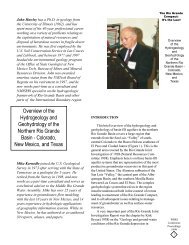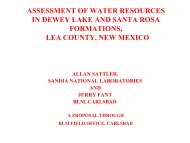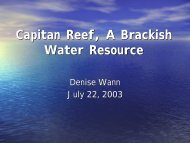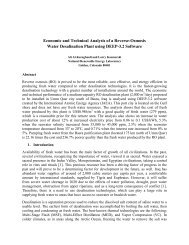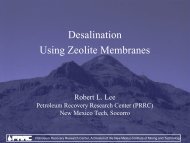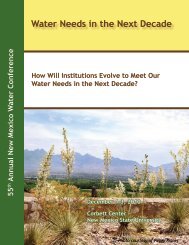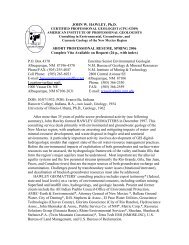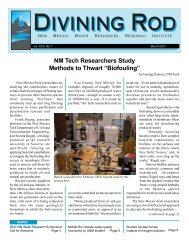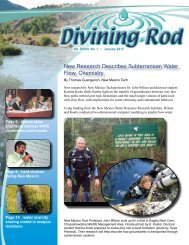Charles T. DuMars - Water Resources Research Institute
Charles T. DuMars - Water Resources Research Institute
Charles T. DuMars - Water Resources Research Institute
Create successful ePaper yourself
Turn your PDF publications into a flip-book with our unique Google optimized e-Paper software.
Prior Appropriation Law and Future <strong>Water</strong> Allocation: Preserving <strong>Water</strong> for Future Generations<br />
THE GOVERNOR’S WATER LAW STUDY<br />
COMMITTEE RECOMMENDS CREATION<br />
OF A GROUND WATER RESERVE FOR<br />
FUTURE GENERATIONS<br />
In 1986 Governor Anaya, noting that virtually all<br />
of the water in New Mexico was nearing full<br />
appropriation and that other states coveted the<br />
resource, created the <strong>Water</strong> Law Study Committee to<br />
evaluate and answer four questions: How much water<br />
is there If there is not enough, what are we going to<br />
do about it And what is the interstate demand for that<br />
resource To what degree can we assure that we have<br />
that resource stay in the state of New Mexico We<br />
found in that study, and I think it is quite accurate, that<br />
there are large amounts of unappropriated ground water<br />
in New Mexico that are currently unavailable by<br />
existing criteria, appropriation criteria. We calculated<br />
the amount with the help of the State Engineer’s Office.<br />
There remained 80 million acre-feet unappropriated<br />
of potable ground water, much of it in the southwestern<br />
part of the state, much of it near planned growth areas<br />
in Mexico and some of it near Tucson.<br />
We also correctly found that these water resources<br />
are vital for the future of New Mexico. Pure market<br />
solutions might not work to preserve those resources<br />
for New Mexico’s future. We were very concerned<br />
then and we suggested, and I still can suggest, in my<br />
view, with respect to that part of the resource, it is<br />
vital to come up with some method of strategic ground<br />
water reserve to evaluate those resources, calculate<br />
our future needs and get a real handle on that. One of<br />
my suggestions was to really focus on that<br />
unappropriated ground water, admit it is there, not deny<br />
it is there for political reasons or otherwise, and make<br />
sure that it is available for future New Mexicans. But<br />
that is really not a prior appropriation issue per se, it is<br />
a water planning issue. We concluded that the public<br />
nature of the resource meant that we should declare<br />
the conservation of that water in storage a beneficial<br />
use within the meaning of the prior appropriation<br />
doctrine and that it should remain forever for New<br />
Mexicans.<br />
The <strong>Water</strong> Law Study Committee consisted of<br />
Robert B. Anderson (Robert O. Anderson’s son),<br />
Gerald Thomas from New Mexico State, Les Davis<br />
of the CS Ranch, Carol Christiano and myself. Tom<br />
Bahr was involved; Al Utton was involved, along with<br />
a number of others who were very, very useful.<br />
What we were concerned about were the effects<br />
on the water market that was inexorably moving toward<br />
expansion where price reflects scarcity in agriculture<br />
and where agriculture cannot compete. And the loss<br />
of agriculture to New Mexico would be devastating<br />
culturally and economically in many sectors. I now<br />
must confess my bias, my background. I grew up on a<br />
ranch. That’s what I know; that’s what I’ve done all<br />
my life. But the reality is, of course, that there is a<br />
water market that<br />
will evolve, needs to<br />
evolve, and there<br />
needs to be clarity<br />
in that market, and<br />
those water users<br />
who cannot compete<br />
must adapt and<br />
adjust. But a state<br />
consisting only of<br />
condo dwellers<br />
importing water to<br />
gravel backyards<br />
was not then and is<br />
One of my suggestions<br />
was to really focus on<br />
that unappropriated<br />
ground water, admit it is<br />
there, not deny it is there<br />
for political reasons or<br />
otherwise, and make<br />
sure that it is available<br />
for future New<br />
Mexicans.<br />
not now my dream for New Mexico.<br />
What the Committee concluded then in 1986 was<br />
that agriculture may not be able to compete with<br />
municipalities and other industries for water from a<br />
strictly economic viewpoint yet the long-term interests<br />
of the state may best be served by sustaining the<br />
healthy agricultural industry in selected areas. Because<br />
the state values its best agricultural land, its unique<br />
cultures, and other fundamental resources such as the<br />
bosques and wildlife, the state may have to acquire<br />
water rights in the market place to keep them, that is<br />
to say hold them in trust to ensure that it is possible to<br />
sustain agriculture. This water trust coupled with<br />
various kinds of research and support could sustain<br />
this special culture. I am happy to say that now in the<br />
legislature years later precisely these kinds of water<br />
trusts are being created for multiple purposes.<br />
We also included on the cover of our report the<br />
following: “let it not be said in one or more decades<br />
hence that the present society knowing the foreseeable<br />
conditions neglected to confront them in all possible<br />
ways.” That was the challenge of New Mexico in 1986.<br />
That is the challenge today.<br />
17





